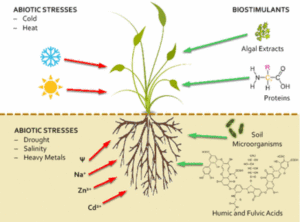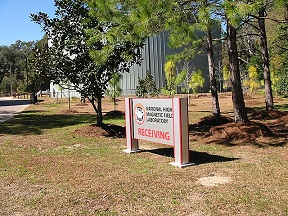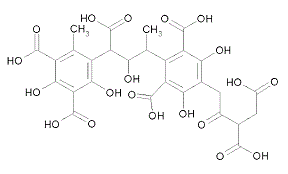Food production needs to increase in view of a growing global population. But modern agricultural practices tend to reduce soil quality. And new research studies prove the negative impact of synthetics. Biostimulants could ease out the tensions posed by these developments.

Food security is essential
Today, modern agriculture plays a central role in unraveling some of the biggest challenges faced by humanity. Global population is increasing and is predicted to reach 9.8 billion by 2050. The agricultural sector, in effect, is under pressure to meet the growing food demand and achieve food security goals.
Secondly, degrading quality of the soil has become a major concern among farmers and agriculturists. According to reliable reports, about 40% of the world’s agricultural soil and 24% of the globe’s productive area have been subjected to loss of fertility, biodiversity, and production capacity.
The third and most important challenge faced by the sector is the growing use of synthetic fertilizers and pesticides for boosting agricultural production. Studies cite that excessive use of fertilizers could accelerate the climate crisis.
As a consequence, environmentally friendly and sustainable farming practices with innovative solutions are now integral to modern agriculture. In order to ensure food production at the desired level, the agricultural sector needs to embrace new solutions and approaches to enhance resource use efficiency. In this regard, biostimulants have emerged as an environmentally friendly and promising innovation for modern agriculture. Biostimulants consist of a blend of plant hormones, microorganisms, trace elements, seaweed extracts, and enzymes. They are applied to crops with the aim to enhance plant growth and development. Biostimulants act as soil conditioners and are known to improve plant growth and crop productivity, enhance flowering, and tolerance against abiotic stressors.

Biostimulants market to surge beyond USD 6.5 billion by 2028
According to a recent report by Global Market Insights Inc, the biostimulants market will grow much in the years to come. In 2021 alone, scientific publications increased by 46% compared to 2020. These studies offer positive insights into the deployment of biostimulants in modern agriculture.
One of the recent research breakthroughs in the biostimulants industry is the impact of humic acid on tomato plants. The research was conducted by a team of researchers at Bio Huma Nectics, in collaboration with an expert from Ion Cyclotron Resonance Facility‘s National High Magnetic Field Laboratory. Humic acid is a loose assembly of aromatic polymers, found in rich soils. The study involved testing biostimulant properties of humic acid on Micro-Tom tomato plants under rising nutritional stress. The study concluded that the humic acid application proved effective in mitigating the nutrient stress of tomatoes. HA increased the crop yield by 19% and offered up to 10% to 24% improvement in fruit quality. The humic acid application also boosted the nutrition level in plants by 25%. These results confirmed the positive role that humic acid plays in improving nutrient efficiency uptake in plants.
A green solution that boosts corn production and quality
The impact of biostimulants on vegetables and fruits is exceptional already. Now their use is being considered on a large scale for enhancing the yield production and quality of row crops, like corn or soybean. According to USDA statistics, corn is widely produced in the United States, accounting for more than 95% of the total feed grain production and usage. In an attempt to suffice the growing crop cultivation, farmers are making use of plant biostimulants.
Since last year many companies have commercialized new biostimulants for farmers to boost corn output and quality.
– In late 2021, Corteva, an agriculture chemical company, publicized its plans to market Utrisha N to help ease concerns about commercial nitrogen losses that may occur through volatilization. They claim that their biological foliar product fixes atmospheric nitrogen and converts it to ammonium for use in corn and several other row crops.
– In 2021, Elicit Plant received a green signal from French regulatory authorities to market its first BEST- a product addressing corn yield issues. Funds would be used to bolster the commercialization of its products in France and other key markets throughout North America, Europe, and South America.

Good prospects for biostimulants
Canada has been facing a soil crisis for a while now. According to reliable reports, soil erosion costs Canadian farmers more than USD 3 billion almost every year, about 3 times the rate from 40 years ago. This has prompted agriculturists to take up sustainable farming approaches and biological farming innovations to augment soil quality and produce profitable yields. To that end, Canada may emerge as a vital revenue hub for biostimulants market players.
In 2022, the federal, provincial, and territorial Ministers of Agriculture across Canada announced rolling out a new framework for the Sustainable Canadian Agriculture Partnership (SCAP). The new 5-year agreement will be built on the existing CAP by offering an additional USD 500 million of investment over $3 billion existing investment in the agriculture sector. This is indicative of government support for the regional agriculture sector, will stimulate the demand for biostimulants in the country. In early 2021, UPL AgroSolutions Canada declared that its first biosolutions product in Canada received registration from the Canadian Food Inspection Agency, supporting its move toward sustainable farming. Labeled as OHM Biostimulant, the product is a highly advanced and concentrated liquid form of Ascophyllum nodosumseaweed extract that optimizes nutrient use efficacy for improved plant development.
Amid the impending food production and distribution crisis, biostimulants can help the farming community accomplish food production targets, redress the impact of unfavorable weather conditions, and make profits with high-quality produce. With increasing R&D programs on the horizon, the biostimulants industry is likely to grow in the coming years. The African continent, over the next five years, is projected to emerge as a potential sales hub for seaweed extract biostimulants. This can be attributed to the rising food insecurity in the region and growing sustainable farming initiatives by governments. The farming community in African nations is also relying on biostimulants on a large scale to boost their crop yields and produce better quality food for the population.
Interesting? Then also read:
Review: biostimulants for sustainable crop production
Plant biostimulation, a new chapter in agriculture
Food security in times of climate change
